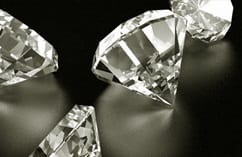Colored gold has rapidly grown in popularity, but there’s a lot of confusion out there about what these different colors are, are they really gold? Can they really be used for jewellery? The truth is, the color of gold is quite flexible, and most colors of gold are as real and pure as your typical piece of yellow gold jewellery; many rose golds and white golds have purities as high as 18k.
The Common Golds
- Yellow gold. Your traditional yellow gold. The color of gold in its pure form is slightly reddish, as anyone who’s handled 24k gold can attest, with the common alloys using silver and copper presenting the vibrant yellow and pale yellow many associate with the metal.
- White gold. An alloy of gold using a white metal such as manganese or nickel. Like yellow gold, this type of jewellery is typically measured in karats, and can offer a very wide variety of traits. True white gold embodies any number of very pale colors; pale yellows, browns, and reds can all be considered white gold. Many commercial pieces come with a rhodium plating, this is the silver color many associate with white gold.
- Rose gold. These are alloys produced using more copper than would traditionally be used to produce a yellow gold. The more copper, the redder the final product will be, with the palest color being ‘pink gold’, the middle being ‘rose gold’, and the darkest being ‘red gold’. This is usually done by replacing some of the copper with silver or another metal.
Less Common Colors
- Green gold. Electrum is a naturally-occurring alloy of gold made up of silver and gold, appearing as a yellowish-green and sometimes used in jewellery. A true light or dark green can be obtained with cadmium alloys, but the use of cadmium for jewellery isn’t advised due to health concerns.
- Gray gold. Essentially a type of white gold, with very specific ratios to produce a duller color. This is produced using palladium, or with a careful mix of silver, manganese, and copper.
- Black gold. This actually refers to gold exposed to a variety of surface treatments, such as rhodium electroplating, patination, vapor deposition of carbon, or careful oxidation of certain gold alloys. The various surface colors produced by these and other methods can be brown, black, or olive in color.
- Blue gold. There are two forms of blue gold out there. One is produced like black gold, with a special surface treatment involving the oxidation of certain gold alloys, which produces a strong blue. This is a true alloy of gold and indium or gallium, which forms a compound with a blue hue that turns the gold bluish-gray.
- Purple gold. Like the latter form of blue gold, purple gold is produced with certain alloys of gold which produce intermetallic compounds. In this case, gold and aluminum. Due to being unusually brittle, it’s rarely been used as a primary material in jewellery. Instead, it’s often treated more akin to a gemstone and placed inside a setting. More recent advances have allowed the production of sturdier forms of purple gold, allowing the material to be used alone or with other golds.
As you can see, there are many options out there. While some are arguably just fancy covers placed on normally-colored gold, all are true golds. It’s all a matter of how the color is shaped by the other compounds. So, choose the color of gold that’s going to make you or your loved one most happy, it’s all the real thing.
If you’re looking to sell your colored gold, or have more questions about gold in general, visit us at our location near the intersection of Yonge, or contact us online today!








